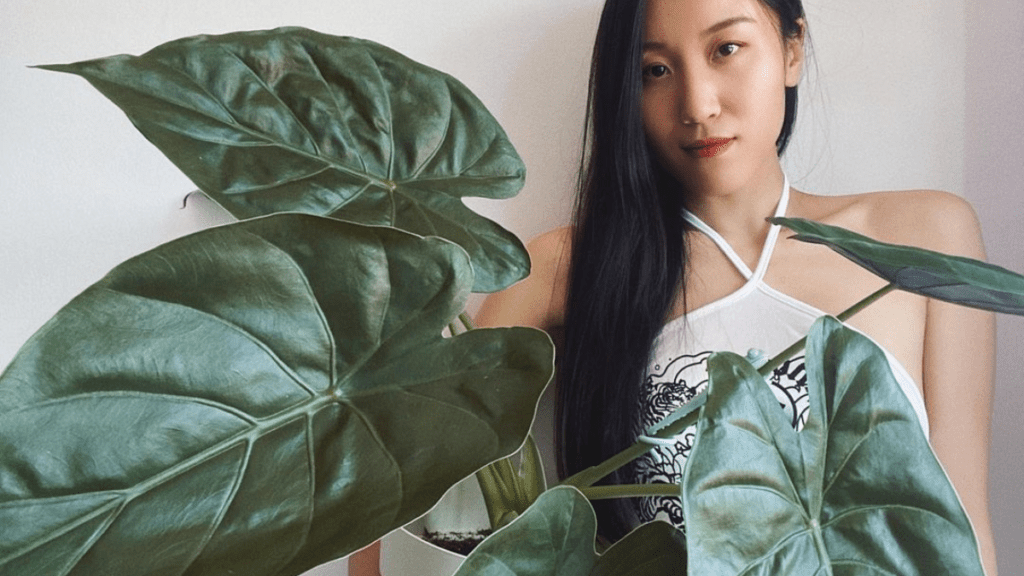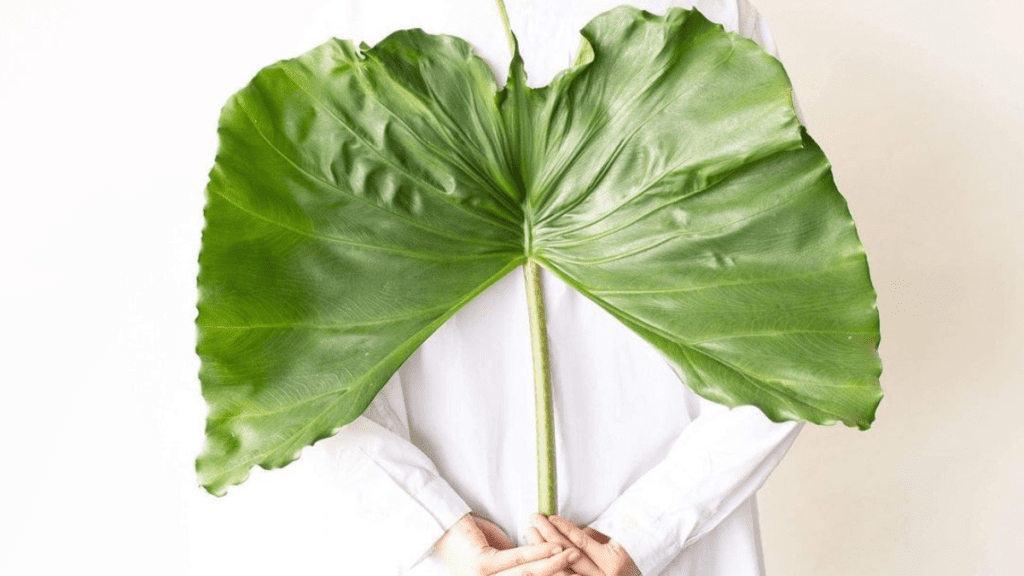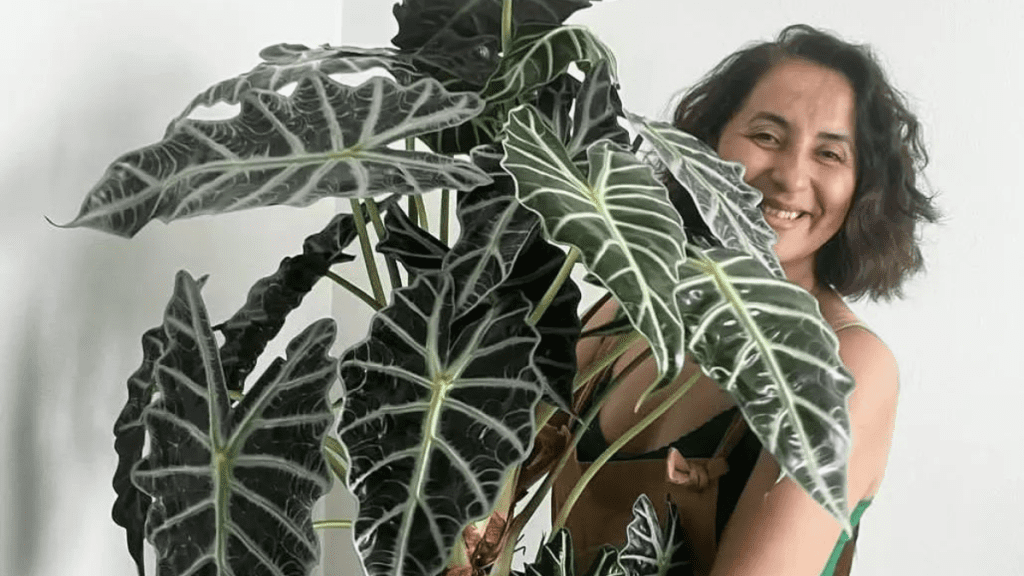Welcome to the vibrant world of Alocasia Zebrina, where lush foliage and captivating beauty converge to create an enchanting indoor jungle. If you’re seeking to elevate your plant collection with a statement piece that commands attention, look no further than this stunning botanical wonder.
With its striking coloration and intricate leaf structure, the Alocasia Zebrina is sure to captivate plant enthusiasts and casual observers alike.



Getting to Know Alocasia Zebrina
Native to the rainforests of Southeast Asia, Alocasia Zebrina is renowned for its distinctive appearance and tropical allure.
It boast’s elongated, arrow-shaped leaves adorned with striking zebra-like stripes, which lend it a sense of exotic elegance. These leaves can grow to impressive sizes, adding a bold statement to any indoor space. Additionally, the plant’s vibrant green foliage contrasts beautifully with its prominent white veins, creating a visually stunning display.
One of the most intriguing features of Alocasia Zebrina is its ability to undergo a phenomenon known as “nyctinasty.” This means that the plant’s leaves respond to changes in light by opening and closing, a fascinating adaptation that adds to its allure.
In terms of size, Alocasia Zebrina typically reaches heights of around two to three feet indoors, although it can grow larger under optimal conditions. Its rhizomatous root system spreads gradually, making it an excellent candidate for container gardening.
Understanding Alocasia Zebrina’s Needs

To truly excel in caring for your Alocasia Zebrina, it’s imperative to delve into the intricate nuances of its needs and preferences.
Lighting: Alocasia Zebrina thrives in environments where it receives ample but indirect sunlight. Understanding its light requirements is akin to orchestrating a delicate dance between brightness and shade.
While the plant relishes bright, filtered light, direct sunlight can be detrimental, causing its delicate leaves to scorch and fade. Thus, finding the perfect balance is paramount. Consider positioning your Alocasia Zebrina near a north or east-facing window, where it can bask in the gentle rays of the morning sun without experiencing the harsh glare of midday.
Temperature and Humidity: In the tropical rainforests that Alocasia Zebrina calls home, warmth and humidity reign supreme, enveloping the plant in a nurturing embrace. Replicating these conditions in your home is essential for fostering its well-being. Aim to maintain a temperature range between 65°F and 80°F (18°C to 27°C), steering clear of sudden fluctuations that may unsettle the plant.
Additionally, elevate humidity levels by incorporating strategies such as misting the foliage regularly, grouping plants together to create microclimates, or investing in a dedicated humidifier. Alternatively, placing your Alocasia Zebrina on a pebble tray filled with water can provide a localized boost in humidity, ensuring its leaves remain lush and hydrated.
Soil: The foundation of successful Alocasia Zebrina care lies in the quality of its soil. Unlike conventional potting mixes, which may suffocate the plant’s roots with excessive moisture, a well-draining blend is essential for promoting healthy growth.
Craft a customized mixture using components such as peat moss, perlite, and compost, which strike the perfect balance between moisture retention and aeration. This tailored approach ensures that water flows freely through the soil, preventing waterlogged conditions that could spell disaster for your botanical companion.
Providing the Perfect Environment



Creating an optimal environment for your Alocasia Zebrina involves more than just meeting its basic needs; it requires a thoughtful approach that considers every aspect of its well-being. From lighting to humidity levels, each element plays a crucial role in shaping the plant’s growth and vitality.
Lighting: As a species native to the understory of tropical forests, Alocasia Zebrina thrives in environments with ample but indirect sunlight. When selecting a spot for your plant, aim for a location that receives bright, filtered light without exposing it to direct sunlight, which can scorch its delicate leaves. Consider placing it near a north or east-facing window where it can enjoy gentle rays throughout the day.
Temperature and Humidity: Replicating the warm, humid conditions of its native habitat is essential for the well-being of your Alocasia Zebrina. Maintain a temperature range between 65°F and 80°F (18°C to 27°C), avoiding sudden fluctuations that may stress the plant. Elevate humidity levels by misting the foliage regularly, placing a humidifier nearby, or creating a pebble tray filled with water to provide localized moisture.
Container: Selecting the right container for your Alocasia Zebrina is another critical consideration. Opt for a pot with drainage holes to allow excess water to escape, preventing waterlogging. Additionally, choose a container that provides ample space for the plant’s rhizomatous root system to spread comfortably.
Watering Your Alocasia Zebrina

In the delicate art of watering your Alocasia Zebrina, precision and intuition merge to create a harmonious balance that sustains the plant’s health and vigor. Understanding its unique hydration needs is essential for preventing both under- and over-watering, which can jeopardize its well-being.
Frequency: The frequency of watering your Alocasia Zebrina depends on various factors such as environmental conditions, pot size, and soil composition. As a general guideline, aim to water the plant when the top inch of soil feels dry to the touch. Avoid watering on a fixed schedule and instead, let the plant’s moisture levels dictate your actions.
Water Quality: The quality of water you use can significantly impact the health of your Alocasia Zebrina. Opt for filtered or distilled water to avoid exposing the plant to chemicals such as chlorine and fluoride, which can harm its delicate roots. Alternatively, allow tap water to sit overnight to allow any chlorine to dissipate before using it for watering.
Signs of Overwatering/Underwatering: Understanding the signs of overwatering and underwatering is crucial for adjusting your watering routine accordingly. Overwatering may manifest as yellowing leaves, mushy stems, or wilting foliage, while underwatering can result in dry, crispy leaves and drooping growth. Pay close attention to your plant’s appearance and adjust your watering frequency as needed to maintain optimal moisture levels.
Feeding and Fertilizing
Nourishing your Alocasia Zebrina goes beyond mere sustenance; it’s an art form that involves providing the essential nutrients needed to fuel its growth and vitality.
Nutritional Needs: Like all living organisms, Alocasia Zebrina relies on a balanced diet to thrive. In its native habitat, the plant draws nutrients from the rich, organic matter found in the forest floor. To replicate these conditions in your home, opt for a balanced fertilizer formulated specifically for tropical plants. Look for products with a balanced NPK ratio (nitrogen, phosphorus, potassium) to ensure all essential nutrients are provided in the right proportions.
Fertilizing Schedule: Establishing a regular fertilizing schedule is essential for promoting robust growth and vibrant foliage. During the plant’s active growing season, typically spring and summer, fertilize every two to four weeks to provide a steady supply of nutrients. Reduce feeding frequency during the fall and winter months when the plant’s growth slows down.
Choosing the Right Fertilizer: When selecting a fertilizer for your Alocasia Zebrina, opt for a well-balanced, water-soluble formula that’s suitable for tropical plants. Avoid over-fertilizing, as this can lead to nutrient imbalances and damage to the plant’s delicate roots. Follow the manufacturer’s recommendations for dilution and application to ensure optimal results.
By nourishing your Alocasia Zebrina with the right blend of nutrients at the right times, you’ll lay the foundation for robust growth and lush foliage that will transform your indoor space into a verdant oasis.
Pruning and Maintenance
Maintaining the beauty and health of your Alocasia Zebrina requires occasional pruning and meticulous upkeep to ensure its foliage remains lush and vibrant. By incorporating regular maintenance into your care routine, you’ll not only enhance the plant’s aesthetic appeal but also promote its overall well-being.
Removing Dead or Damaged Leaves: Periodically inspect your Alocasia Zebrina for any dead, yellowing, or damaged leaves, and promptly remove them to maintain a tidy appearance. Use clean, sharp scissors or pruning shears to make clean cuts, ensuring minimal stress to the plant.
Pruning Tips: When pruning your Alocasia Zebrina, focus on removing any overgrown or leggy stems to encourage new growth and maintain a compact, bushy appearance. Additionally, trim back any yellowing or browning foliage to improve the plant’s overall aesthetic and prevent the spread of disease.
Cleaning: Dust and debris can accumulate on the leaves of your Alocasia Zebrina, inhibiting its ability to photosynthesize and potentially attracting pests. Regularly wipe down the foliage with a damp cloth or gently spray it with lukewarm water to remove dust and keep the leaves clean and healthy.
Propagation Techniques
Venturing into the realm of propagation with your Alocasia Zebrina opens a door to the wonders of botanical reproduction, allowing you to cultivate new plants and share the beauty of this remarkable species with friends and fellow enthusiasts. While the process may seem daunting at first, with patience and a bit of know-how, you can successfully propagate new specimens to expand your indoor jungle.
Division: Dividing a mature Alocasia Zebrina is a straightforward yet effective method of propagation. Begin by gently removing the plant from its pot, taking care not to damage the delicate roots. Once the plant is free, examine the rhizomes – thick, horizontal stems that grow underground – and identify natural divisions or segments. Using a clean, sharp knife or scissors, carefully separate these segments, ensuring each division has both healthy roots and foliage.
Plant the divisions in individual pots filled with a well-draining potting mix, burying the roots and rhizomes just below the soil surface. Water thoroughly and place the newly divided plants in a warm, humid location with indirect light to encourage root establishment.
Stem Cuttings: Propagating Alocasia Zebrina from stem cuttings is another popular method that yields quick results. Select a healthy stem with at least one node – the point where a leaf attaches to the stem – and use clean, sharp scissors or pruning shears to make a clean cut just below the node. Remove any lower leaves to expose the node, which will develop into roots.
Plant the cutting in a pot filled with moist potting mix, burying the node beneath the soil surface and ensuring the remaining stem is upright. Provide gentle misting to increase humidity and place the pot in a warm, brightly lit location, avoiding direct sunlight. Keep the soil consistently moist, and within a few weeks, you should notice new roots emerging from the node.
Propagation Tips: While propagating Alocasia Zebrina is relatively straightforward, there are a few tips to ensure success. Always use clean, sterile tools to prevent the spread of disease, and select healthy, disease-free plant material for propagation. Maintain a warm, humid environment to encourage root growth, and monitor the newly propagated plants closely for signs of stress or disease. Additionally, be patient – propagation takes time, and it may be several weeks or even months before you see significant growth.
Dealing with Common Issues
Navigating the occasional challenges that arise in caring for your Alocasia Zebrina is an integral part of nurturing a thriving indoor jungle. From pesky pests to pesky diseases, being prepared to tackle common issues head-on ensures that your botanical companion remains healthy and vibrant.
Pest Control: Despite your best efforts, your Alocasia Zebrina may fall victim to unwanted visitors in the form of pests. Common pests that may afflict this plant include spider mites, aphids, and mealybugs. Keep a close eye on your plant for signs of infestation, such as webbing, stippling on the leaves, or sticky residue. If pests are detected, promptly isolate the affected plant to prevent the infestation from spreading. Depending on the severity of the infestation, you may need to use natural remedies such as insecticidal soap or neem oil to eliminate the pests.
Disease Management: While Alocasia Zebrina is relatively resilient, it may still be susceptible to certain diseases, particularly if its care requirements are not met. Common diseases that may affect this plant include root rot, leaf spot, and fungal infections. To prevent disease, ensure proper watering practices, provide adequate air circulation around the plant, and avoid overcrowding. If signs of disease are present, such as yellowing or browning leaves, wilting, or mold growth, take immediate action to address the issue. Remove affected plant parts, improve ventilation, and adjust watering practices as needed to prevent further spread of the disease.
Troubleshooting: Sometimes, despite your best efforts, your Alocasia Zebrina may exhibit signs of distress or decline. Common issues to watch out for include yellowing leaves, drooping foliage, or stunted growth. These symptoms may be indicative of various underlying problems, such as overwatering, underwatering, nutrient deficiencies, or environmental stress. Take a systematic approach to troubleshooting by examining the plant’s growing conditions, including light, water, temperature, and humidity levels. Make adjustments as needed to address any issues identified and monitor the plant closely for signs of improvement.
Celebrating Successes and Challenges
As you nurture this remarkable plant, you’ll undoubtedly encounter moments of joy and satisfaction, as well as moments of frustration and uncertainty. it is through these experiences that you’ll deepen your connection to your botanical companion and grow as a plant enthusiast.
Personal Reflections: Take a moment to reflect on the successes you’ve experienced in caring for your Alocasia Zebrina. Perhaps you’ve successfully propagated new plants, watched as new leaves unfurled, or simply marveled at the beauty of its foliage. These moments of triumph are a testament to your dedication and care, and they serve as a source of inspiration as you continue your plant care journey.
Community Insights: Beyond your own experiences, take the time to seek out insights and wisdom from fellow plant enthusiasts. Whether through online forums, social media groups, or local plant clubs, connecting with others who share your passion for Alocasia Zebrina can provide valuable support and guidance. Share your successes and challenges, seek advice when needed, and celebrate the shared joys of plant parenthood.
Learning and Growth: Embrace the challenges you encounter along the way as opportunities for learning and growth. Every setback offers a chance to refine your care practices, deepen your understanding of your plant’s needs, and become a more skilled and knowledgeable caregiver. Approach each challenge with curiosity and determination, knowing that with patience and perseverance, you’ll overcome any obstacle that stands in your way.
If you’re thinking of extending your alocasia family, I recommend reading up on alocasia frydek and alocasia jacklyn (alocasia tandurusa). They would both make great additions to your squad!
Conclusion
So, embrace the beauty, the challenges, and the joys of caring for your Alocasia Zebrina, and let your indoor jungle thrive with vitality and life. With your dedication and passion, your botanical companion will continue to flourish, bringing endless delight and inspiration to your home.
FAQs
Is Alocasia Zebrina poisonous to pets?
Yes, Alocasia Zebrina is toxic to pets if ingested. It contains calcium oxalate crystals, which can cause irritation and discomfort if pets, such as cats or dogs, chew on the leaves or stems. It’s essential to keep the plant out of reach of pets and to seek veterinary assistance if ingestion is suspected.
Why are the leaves of my Alocasia Zebrina turning yellow?
Yellowing leaves on an Alocasia Zebrina can be caused by various factors, including overwatering, underwatering, inadequate lighting, or nutrient deficiencies. Assess the plant’s growing conditions and make adjustments as needed. Trim off any yellowing leaves to promote new growth and maintain the plant’s overall health.
How often should I repot my Alocasia Zebrina?
Alocasia Zebrina typically needs repotting every 1-2 years, depending on its growth rate and the condition of its roots. Signs that indicate it’s time to repot include roots growing out of the drainage holes, the plant becoming root-bound, or the soil breaking down and becoming compacted. Repot the plant into a slightly larger container using fresh potting mix, taking care not to damage the roots.
How can I increase humidity for my Alocasia Zebrina?
Increasing humidity for an Alocasia Zebrina can be achieved through several methods. You can mist the foliage regularly, place a humidifier near the plant, group it with other plants to create a microclimate, or place a tray filled with water and pebbles beneath the plant’s pot to create localized humidity. Ensuring adequate humidity levels helps the plant thrive and prevents issues such as dry, crispy leaves.

Writer/Green Thumb/Explorer – Rooted deep in the rich soils of Devon, I’ve cultivated a vast expertise in plant care, helping greenery thrive in homes across the UK. When I’m not crafting detailed plant care guides, I’m journeying through the lush landscapes of the West Country, unearthing nature’s secrets and sharing them with fellow plant enthusiasts. Every leaf has a story, and I’m here to tell it.





